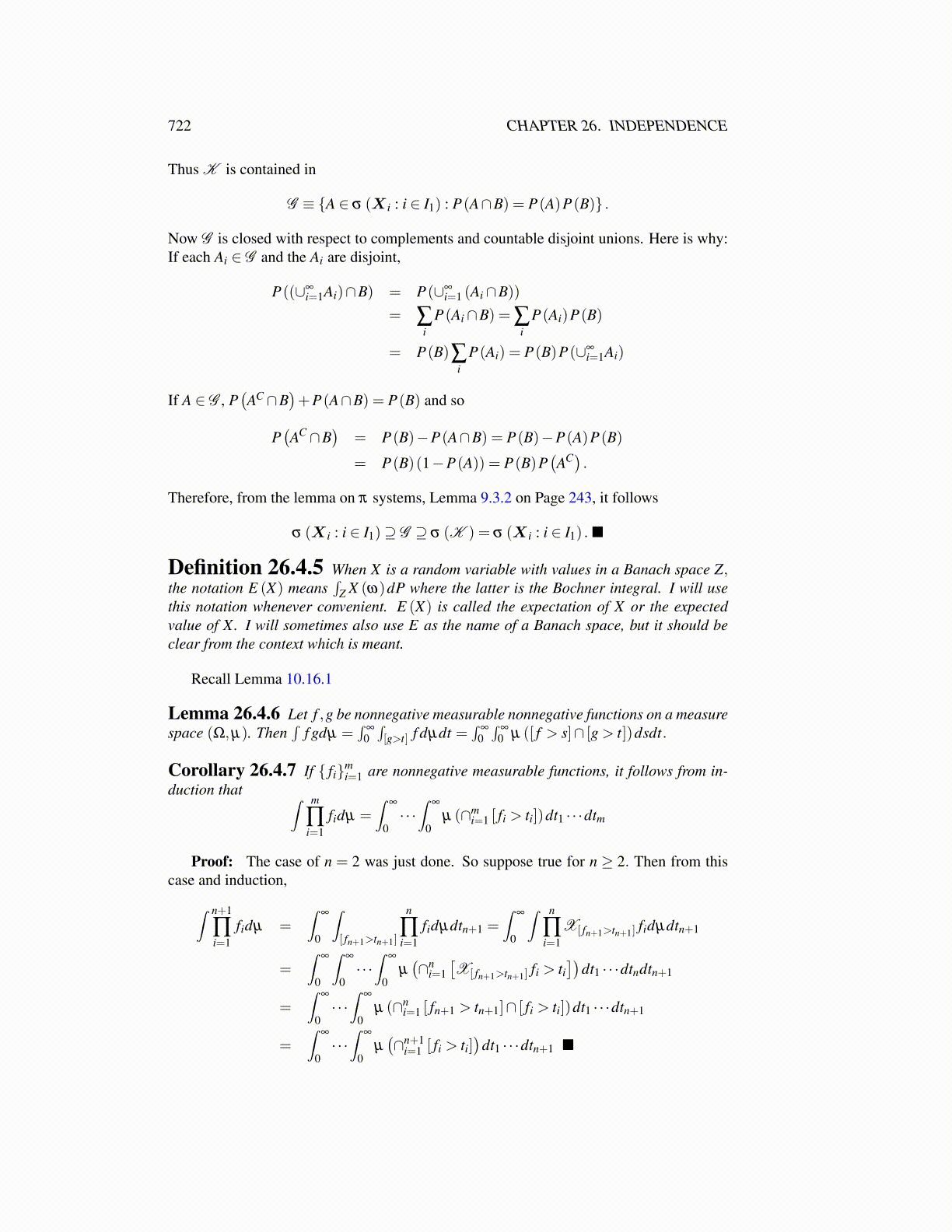
722 CHAPTER 26. INDEPENDENCE
Thus K is contained in
G ≡ {A ∈ σ (X i : i ∈ I1) : P(A∩B) = P(A)P(B)} .
Now G is closed with respect to complements and countable disjoint unions. Here is why:If each Ai ∈ G and the Ai are disjoint,
P((∪∞i=1Ai)∩B) = P(∪∞
i=1 (Ai∩B))
= ∑i
P(Ai∩B) = ∑i
P(Ai)P(B)
= P(B)∑i
P(Ai) = P(B)P(∪∞i=1Ai)
If A ∈ G , P(AC ∩B
)+P(A∩B) = P(B) and so
P(AC ∩B
)= P(B)−P(A∩B) = P(B)−P(A)P(B)
= P(B)(1−P(A)) = P(B)P(AC) .
Therefore, from the lemma on π systems, Lemma 9.3.2 on Page 243, it follows
σ (X i : i ∈ I1)⊇ G ⊇ σ (K ) = σ (X i : i ∈ I1) .■
Definition 26.4.5 When X is a random variable with values in a Banach space Z,the notation E (X) means
∫Z X (ω)dP where the latter is the Bochner integral. I will use
this notation whenever convenient. E (X) is called the expectation of X or the expectedvalue of X. I will sometimes also use E as the name of a Banach space, but it should beclear from the context which is meant.
Recall Lemma 10.16.1
Lemma 26.4.6 Let f ,g be nonnegative measurable nonnegative functions on a measurespace (Ω,µ). Then
∫f gdµ =
∫∞
0∫[g>t] f dµdt =
∫∞
0∫
∞
0 µ ([ f > s]∩ [g > t])dsdt.
Corollary 26.4.7 If { fi}mi=1 are nonnegative measurable functions, it follows from in-
duction that ∫ m
∏i=1
fidµ =∫
∞
0· · ·∫
∞
0µ (∩m
i=1 [ fi > ti])dt1 · · ·dtm
Proof: The case of n = 2 was just done. So suppose true for n ≥ 2. Then from thiscase and induction,
∫ n+1
∏i=1
fidµ =∫
∞
0
∫[ fn+1>tn+1]
n
∏i=1
fidµdtn+1 =∫
∞
0
∫ n
∏i=1
X[ fn+1>tn+1] fidµdtn+1
=∫
∞
0
∫∞
0· · ·∫
∞
0µ(∩n
i=1[X[ fn+1>tn+1] fi > ti
])dt1 · · ·dtndtn+1
=∫
∞
0· · ·∫
∞
0µ (∩n
i=1 [ fn+1 > tn+1]∩ [ fi > ti])dt1 · · ·dtn+1
=∫
∞
0· · ·∫
∞
0µ(∩n+1
i=1 [ fi > ti])
dt1 · · ·dtn+1 ■